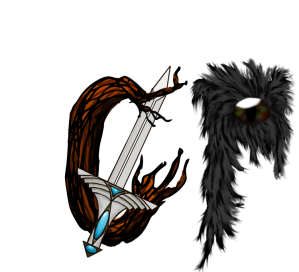How to Design a Character
I’ve gotten loads of questions surrounding how I make my story, characters, plot, creatures, world, etc. So I decided to lead you all through the exciting world of character design. So say you’ve done some research. You know what time period and genre you want your book to be. Before you get too much into developing the world and the plot, you’re gonna want to work on some characters. So uh. How do you do that?
If you go on YouTube, you’ll notice that lots of people have discussed how they make up a character design. However, no one really goes into how they made up the character – not just the appearance. They’ll describe how they color an original character (or OC) and probably how they design an outfit. But no one describes how they made the character itself – with the family, other background, powers, personality, etc. They just cover the physical appearance, and that’s it.
Just like real-life people, characters are more than just a pretty face though.
Well, today’s your lucky day, guys. I’m about to describe how I do it – the whole shebang all the way from appearance to the character’s background (backstory kind of background, not trees and buildings behind a person in a picture type of background). Needless to say, this paper doesn’t mean you have to design characters like this, and that certainly doesn’t mean this is the only way of doing so. I will try to cover as much information as I can without making this an unbearably long read.
First, it is important to understand the elements of characters. Every character has a few main parts. I don’t care how different, diverse, special, amazing, dumb, redundant, or whatever else your characters are like. They’re all going to have basic fundamentals (whether you call it these terms or not.) Think of an actual person. Each person on the planet has to have something that makes them tick. Something that they enjoy or a goal. Family. Sure, they’ll likely have something in common with at least one other person, but they’re probably all going to be at least somewhat different from each other. Coincidences are fine, but when ‘coincidences’ are common in all your characters, you’ve got a problem. (Keep in mind that families or close friends can have a lot of similarities in their personality and such, but they shouldn’t be so similar that they could be the same character.) Anyways, I’ve made a list of elements that I think each character has:
Character’s Elements
- Physical appearance
- Gene traits
- Gender
- Eye color, etc.
- Non-genetic appearance stuff too
- Dyed hair color
- Weight
- Scars, etc.
- Outfit
- Accessories too
- Weapon
- Powers, like wings.
- Gene traits
- Personality
- Interests/ hobbies
- Power/gift/something he/she excels at
- Personality itself
- Feel free to use the Meyer’s Briggs test if that makes it easier
- Background
- Family
- Goal/purpose
- Other
- Race (or species, depending on genre)
- Religion (depending on genre)
- Social Status
- Sexual Orientation
- Character Development
(Side Note: When I say, “depending on genre” or “if your genre allows it,” that just means that if it’s appropriate for your genre. For example, for science fiction, it makes sense to have aliens and robots. But designing an alien wouldn’t fit in an autobiography, for example. My book is fantasy, so my creatures fall in the lines of mermaids, ogres, dwarves, etc. You can do as you please, but I suggest changing your genre if you don’t want to follow your previous idea.)
Everyone has a reason to do something. Even if it’s as simple as, “This is Rose. Rose likes ice cream. She wants to eat all the ice cream, so she does.” And boom, plot done. Now obviously, that’s a pretty short (predictable and boring) plot. But that would work, for a children’s book presumably. It makes sense. Rose likes ice cream, so you better believe she’s gonna eat all the ice cream. If she had to choose between a cookie and ice cream, she’ll probably choose the ice cream. That being said, if she didn’t like ice cream, she would NOT eat the ice cream. Simple so far, right?
It’s important to understand that when you want to create good characters, you need to give them enough space and time to grow and develop (which is called *drumrolls* : character development!) Rose might grow up hating ice cream. She had it so much as a child that she’s tired of it. Or maybe she stopped enjoying the sugar highs, or maybe she was uncomfortable about her body image. It’s up to you how to describe your Rose, but let her grow up by herself as much as possible, or she won’t survive. Characters can easily get boring and what is called “out-of-character,” meaning the Author writes them or depicts them in a way that doesn’t suit the Character. They’re acting like a completely different person. Think of it like the Author taking the reigns so the Character can’t drive his/her own life anymore. For example, if an Author really wants two characters to be a couple, those two could easily “fall in love” too easily. The relationship would be forced and unbelievable. As an Author, you must be careful of this. This is why Character Cards are so important, but I’ll explain that later.
Character design can be a tricky thing because you’re taking all of these elements – physical appearance, personality, and background – and thinking about and developing them all at once. I want to say that character design is a cycle – one element leads to the next. But it really isn’t. It’s more of a tangled web that sometimes leads to disaster, and sometimes leads to…. well, less of a disaster that you’ll keep tweaking until it’s refined enough for your liking. You’re honestly, basically juggling a hot mess of absolute crap until everything finally starts settling into place.
The hard part is starting. So, by now you’re probably wondering, “Woman, would you just tell me how do I start?” Alright, alright, I will now. In my defense, previous information was important so.
There are two common ways I design characters. I either doodle and then come up with the background… or I do the complete opposite – I make what is called a Character Card (which is basically the background information) and THEN I make the appearance.
What’re the differences? Personally, I am more of a right-brained, creative type of person, so I typically doodle a character and then I make the background information for it. It’s just easier for me to start doodling and realize 5 minutes later that I just drew a super cool outfit. Whether or not you’re good at drawing doesn’t matter; you can still do it (which I’ll explain later.) Or you can create the character and THEN the appearance. This helps you plan the appearance. But for me, the appearance comes more naturally and the information just tumbles into place as I’m drawing. So I prefer the appearance, but you certainly should do whatever is best for you (doesn’t even hafta be one of my techniques at all). Regardless of preferences, I will demonstrate both ways.
I also wanted to show how I do creatures vs more of a human or human-like type of character.
So I will use the drawing method and then Character Card with the creature first. And then, I will create a character card and draw the character for the human type.
Now keep in mind that the characters I create have been thought over A LOT. And were not typically forced in their creation. If you’re following along with me, you might be forcing yourself, but as long as you understand overall what’s happening, you’ll be golden.
Alright, let’s get started! Grab yourself some paper and pencils, notebook paper to make character cards, or some character maker websites!
Want some resources? Click this to go to my resources page just for Character Design!
This is for you if you don’t want to draw or don’t consider yourself to be good at drawing. I am not at all, by any means, an expert drawer. I do enjoy it, and it’s easier for me than using these resources. So whichever resource you prefer is the right one for you. 🙂
I will do the creature first – so drawing and then background development. So I’m starting with a blank page. Absolutely no tricks up my sleeve. Magician’s hat is empty. No bunnies or anything. I have not done anything to prepare. All I know is my book genre (fantasy) and I know what kind of character I can make (human, creature, spirit), though in this example, it’ll be creature. The genre and type of character are probably all you know at this point too.

The nice thing about creatures is that they don’t have to – in fact, it’s probably better if they don’t – resemble a human at all. So just block out some random shapes for now. We can add details later.

Now think about some basic characteristics. Do you want the creature to be cute, cool, creepy, gross, goofy, funny, etc.? Choose some characteristics now. I chose creepy and gross; I don’t have enough of those creatures. If you already have a species or branch of creature in mind, then design the animal according to that. I have one that is basically the physical, monster form of humans’ fears. I think this creature will be one of those. I only have two others, so don’t worry guys. I still have no idea what I’m doing for this character yet, either.
Alright. Now. Time to develop some characteristics. Just keep adding more and more detail. Building over ‘layers’ so to speak. While I’m drawing, I’m getting some ideas about what this character could be like. You can jot those down while you draw or design. Try to imagine how your character/creature could function. Does it need to hear? See? What about smell, touch, and taste? Make sure you have parts of the body that could do the things. Feel free to make up organs and stuff if the genre allows it. And. If it’s a creature, I assume your genre does allow it.
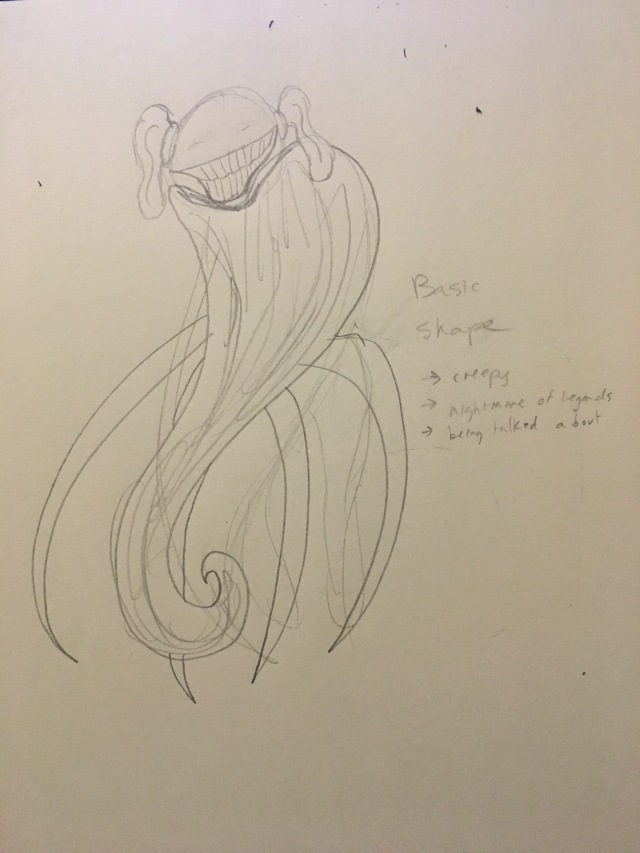
Add more detail – as many layers of detail as you need. My character is relatively simple. My monsters of fear / types of creatures actually revolve around the five senses, so I want their design to be rather simple. These creatures don’t live in the sense as they need to eat, drink, sleep, and get rid of wastes. They function a different way, so I didn’t need to worry about it. This is also where you start thinking about defects and textures. A character isn’t perfect; it could be as silly as having a mole at the very least. So now’s the time to add that in if you feel the character needs it.
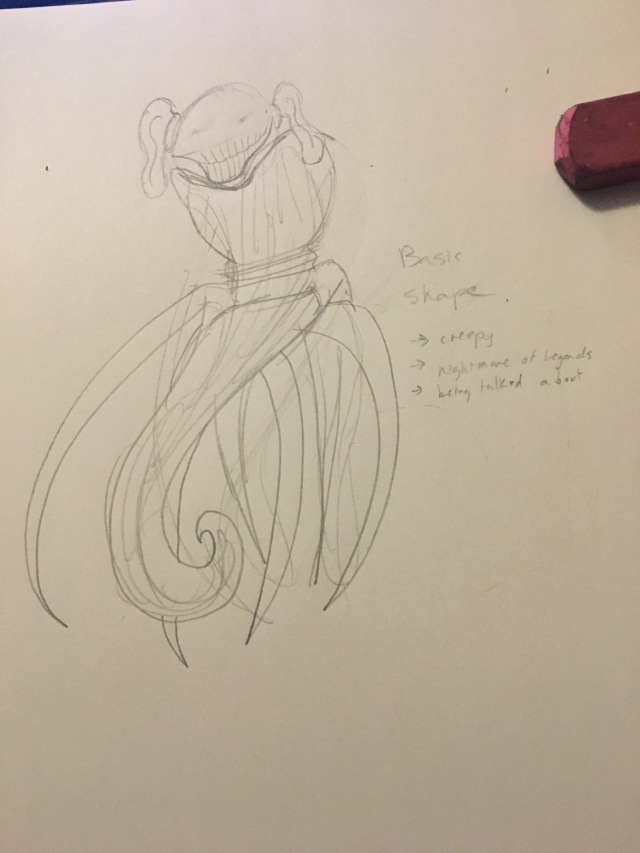
I personally also color, ink, and shade my drawings too. For this character, the color isn’t very important so I didn’t do that. The choice is up to you. So if you wish, it is an excellent way to develop character designs.
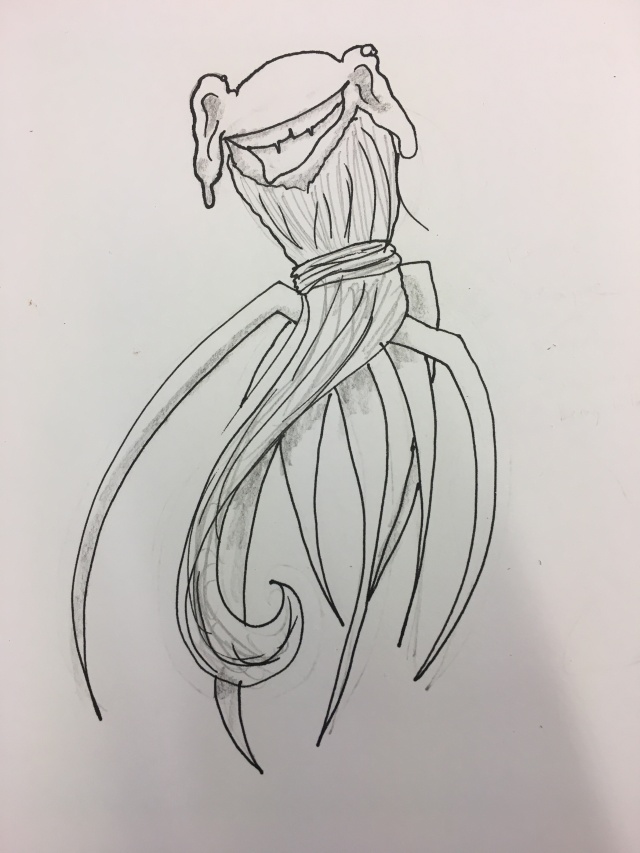
I made my character have a somewhat of a spider inspiration. I made a type of creature called nightmares, so human fears have a physical monster form. This one is the fear of rumors and being gossiped negatively about. So I made the creature have large, warty ears and a big mouth with old, unkempt teeth. Its beard is wrapped around several times to indicate that the monster has whispered bad thoughts to multiple people and it’s begun to make him be in a tight spot (haha.)
So now I have my character, and I hope you do too. Now you need to figure out the background of the story. Based on my character’s appearance, I’d say he thrives off human fears, and his power is being able to whisper in thoughts of another person that aren’t actually there. He’s more of a creature, so he doesn’t really have a personality or hobbies. This creature is from a branch of species called nightmares. They exist to cause fear, which is their motive.
My ‘character card’ is just a few sentences long, but it was pretty simple. I just followed the elements. For human like characters, but using the same drawing to card method, you can still do the blocking out shapes, details, and refine steps.
Now I’ll do the opposite with a human-like character – creating the character card and then the appearance.
Okay. I’ll just copy pasta the list here so we don’t have to keep scrolling up and down.
Character’s Elements
- Physical appearance
- Gene traits
- Gender
- Eye color, etc.
- Non-genetic appearance stuff too
- Dyed hair color
- Weight
- Scars, etc.
- Outfit
- Accessories too
- Weapon
- Powers, like wings.
- Gene traits
- Personality
- Interests/ hobbies
- Power/gift/something he/she excels at
- Personality itself
- Feel free to use the Meyer’s Briggs test if that makes it easier
- Background
- Family
- Goal/purpose
- Other
- Race (or species, depending on genre)
- Religion (depending on genre)
- Social Status
- Sexual Orientation
- Character Development
So in this method, we’re doing the physical appearance last. So.
Let’s start with the background. I usually just spend 2 or 3 minutes of thinking and brainstorming. It’s not free writing; nothing has to keep coming out of your pen. It’s your brain that needs to keep busy!
So. Let’s say I want another side character. She should have 1 younger sister. Parents are good, but they’re a bit distant. So she’s basically the mom of the family. When she’s not with her family, she’s a completely different person – fun-loving, carefree, maybe a little mischievous with the pranks. Basically, everything she can’t be with her family. She’ll be bisexual, have brown eyes, blonde hair, and slightly gold skin. I’m thinking a sun spirit? Or at least a light spirit. Alright. We’ve done Background.
Let’s do Personality. I’ve done a bit already – strict and motherly when she’s with her family and fun-loving mischievous without them. She’ll be a sun spirit, so her powers will presumably be fire, light, and heat. Her hobbies…. This one’s a tough one to think for this character. If you’re struggling, try to think of your other characters. If you want your character to be similar or different, think in correlation to that. I want mine to be different from my other characters, since this is my first sun spirit. Plus, I have a lot of characters that cover the same hobbies – singing, music in general, drawing, writing, etc. I’m thinking something that’s difficult to do for most people… But maybe something that she might not have had to practice a lot. That, with earlier today I made my voice sound funny with my friends – I think I’ll make her hobby be ventriloquism.
Notice how my human-like character’s card is way longer than my creature’s? Yours will probably be similar too. Human-like characters have a personality, humor, the ability to think beyond what’s needed to survive. Creatures will be more of how they can reproduce, eat, sleep, etc. Human-like characters also will need to be more thought out because you want the characters to be relateable for your reader. (Or maybe be hated by your reader.) It’s hard to be emotionally invested in a creature that’s just driven by instincts.
Now, what she’ll look like. I’ll still be using fairly similar methods; but now I know what type of spirit she is, gene traits. I just need to think of what a sun spirit would wear.
First. Block out the basic shapes. She’s mischievous without her family, and since I’m just drawing her by herself, she’ll have a bold, confident stance with a mischievous little smirk. Personality is extremely important for pose-making.

I usually also jot down some basic physical appearances that I already thought of for gene traits, so you can keep that in mind while you’re drawing. I added some more detal. Her hair, where her facial features will be, some basic line ideas for her outfit.
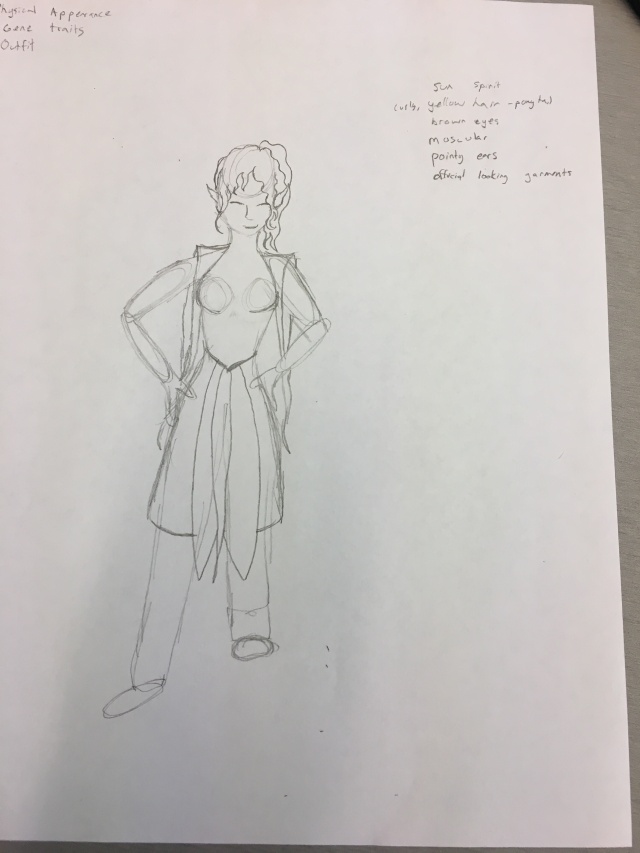
Here I added more details, like her eyebrows, eyes, little more detail on her outfit. I defined the body a little more – like her arm muscles and feet. (Again, I’m not an expert so forgive the rough sketches.)

I added way more details on her outfit and crown.
 And then you ink, shade, color, whatever it.
And then you ink, shade, color, whatever it.

I hope this helped with trying to figure out how to design characters and the appearance. As always, if you have any questions, then let me know.
